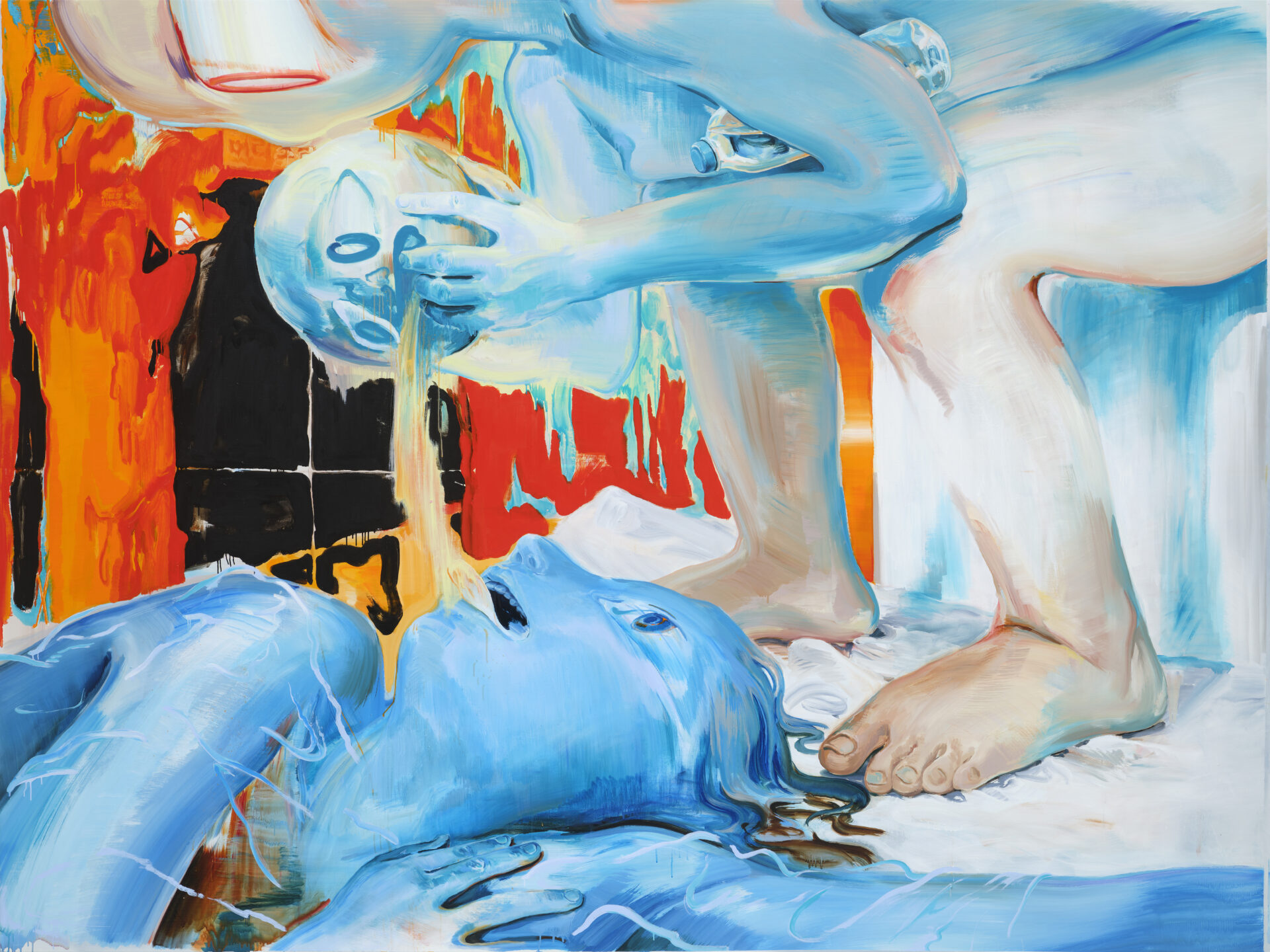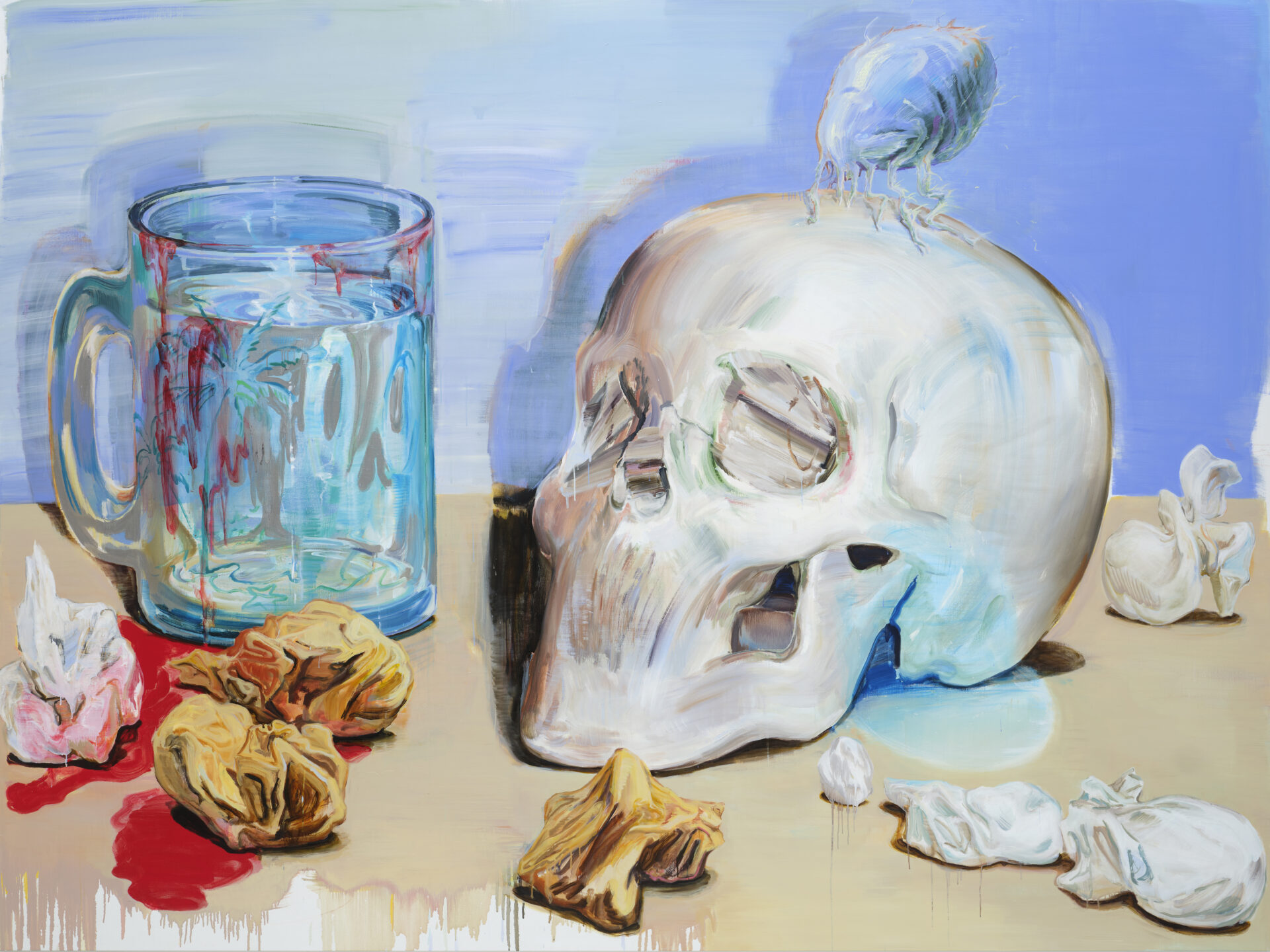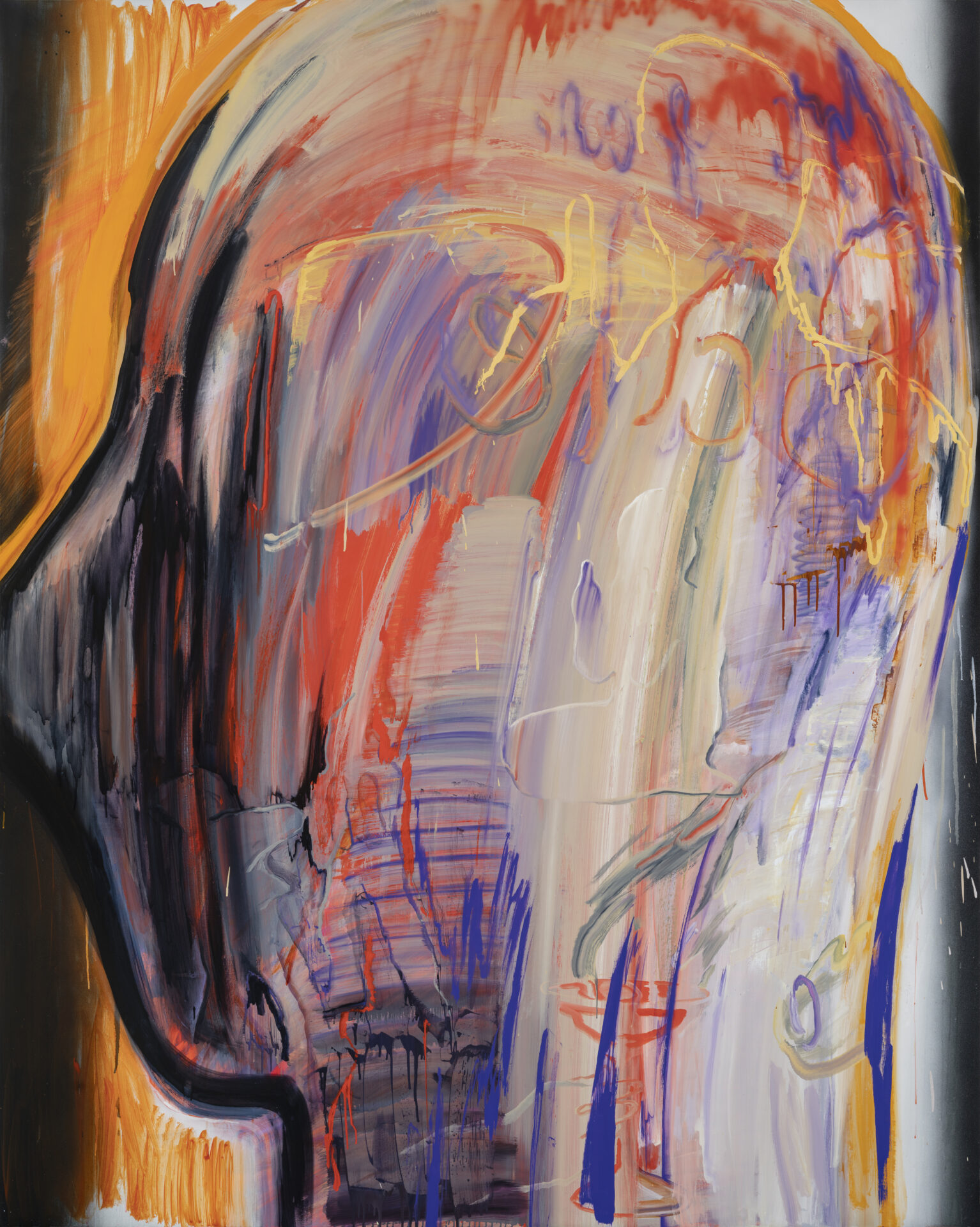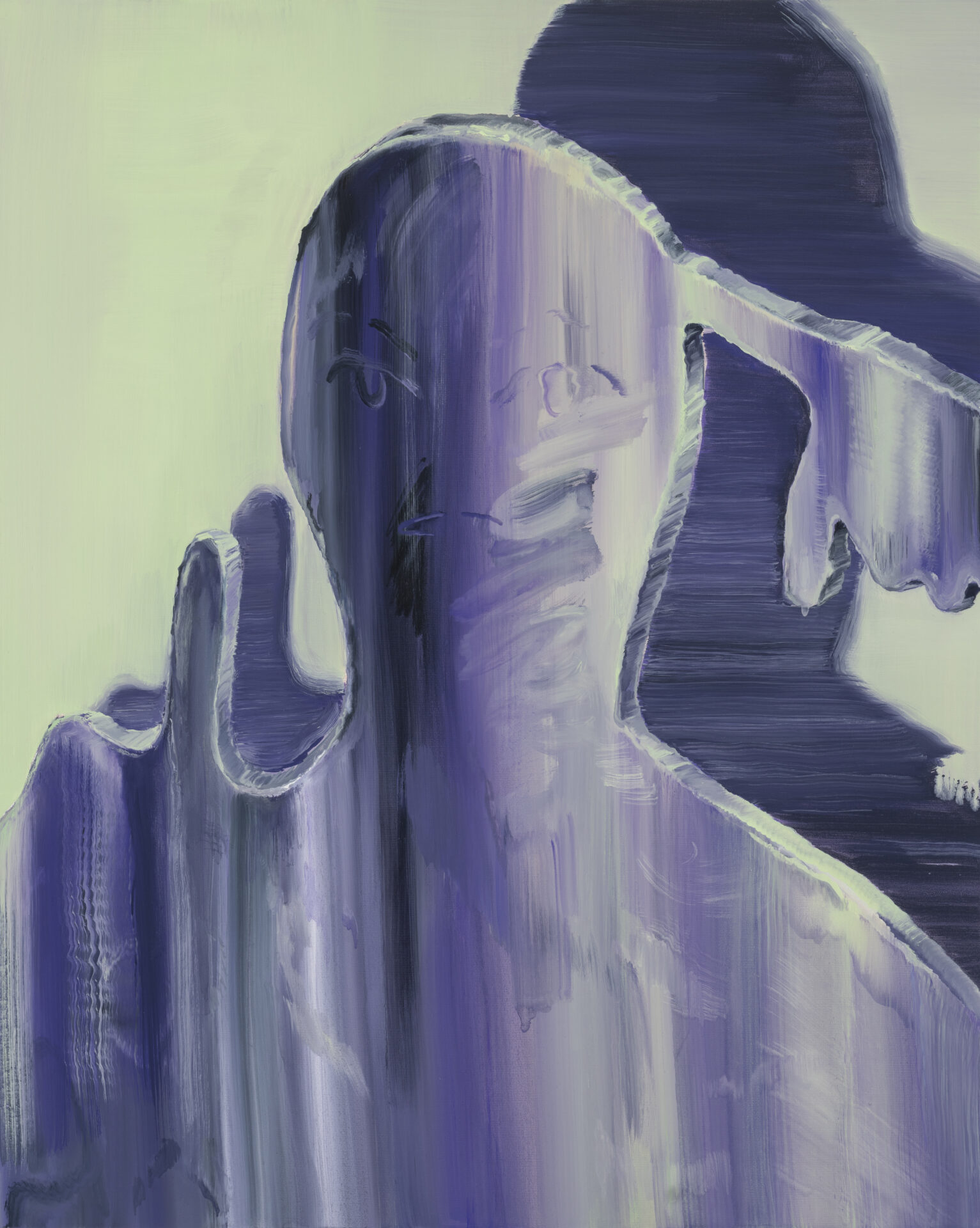〈Mite Life 1〉과 〈Mite Life 2〉는 〈Mite Life〉의 연작으로 2023년 동명의 개인전에서 선보였던 작품들이다. 이은새는 〈Mite Life〉 연작을 통해 인물과 상황에 집중했던 이전 작품들과 달리 사물에 주목한다. 연작의 제목에서 ‘마이트(mite)’는 ‘진드기’라는 뜻도 있지만, ‘어린 것(가엽게 여겨지는 아이, 동물 등)’을 의미하기도 한다. 작가는 개인적인 경험과 역사적인 이야기를 ‘물’이라는 공통된 사물로 접점을 만들고, 한편엔 진드기에 대한 사소한 에피소드를 담아낸다. 물과 진드기, 이 두 개의 소재는 우리가 일상적으로 마주하지만, 관심을 두지 않는 사물이라는 공통점을 갖는다. 그런 의미에서 이은새의 작품 제목 속 ‘마이트(mite)’는 ‘가련하고 작은 대상’을 가리킨다. 〈Mite Life 1〉은 원효대사에 관한 설화를 담고 있다. 설화 속 ‘물’은 원효대사에게 깨달음을 가져다주는 중요한 사물인데, 사물로 인해 변화를 맞이한 인물에 작가는 자신의 경험을 겹쳐 놓는다. 그리고 우리가 당연하게 생각했던 상황이나 원칙을 이 평범하고 작은 사물이 뒤엎을 수 있음을 보여준다.
작품 제목인 ‘마이트 라이프(Mite Life)’는 정물화를 의미하는 영어 ‘스틸 라이프(still life)’를 은유한다. 이은새는 정물화 중에서도 17세기 네덜란드에서 유행했던 바니타스(Vanitas) 정물화를 작품의 소재로 가져왔는데, 당시 유럽은 흑사병과 종교개혁으로 순식간에 삶과 일상이 황폐해지고 파괴되는 것을 목격하였다. 이러한 경험은 예술에도 영향을 미쳤는데, 인간의 유한함과 현세의 덧없음에 대해 성찰하는 정물화가 등장한 것이다. ‘공허하고 헛된’, ‘가치없음’을 의미하는 라틴어 ‘바니타스’와 같이, 바니타스 정물화는 삶과 죽음을 지시하는 사물들을 하나의 화면에 담아내며 반성과 성찰을 유도한다. 이은새는 이러한 바니타스 정물화의 어법을 통해 사물의 가능성을 발견한다. 〈Mite Life 2〉에는 화면 안에 크게 자리한 해골을 중심으로 눈물 혹은 콧물을 닦아낸 휴지 더미, 가소롭지만 공포스러운 진드기가 등장한다. 작가는 눈에 잘 띄지 않고 정지되어 있어 아무 기능도 하지 않을 것 같은 이 사물들을 통해 그것이 우리에게 던지는 질문을 가시화하며, 사물이 지닌 전복적인 힘에 주목한다.
〈회한의 옆통수〉는 ‘후회의 감정’을 시각적으로 표현한 작품이다. 이은새는 이전 작품의 이미지들을 겹치고, 물감을 닦아내며 뒤섞는 등의 기법으로 거대한 얼굴의 옆면을 완성하였다. 작가는 과거 여성의 신체를 주제로 한 자신의 작품들이 의도와 다르게 소비되는 것을 보며, 이에 대한 자기반성과 후회의 감정을 이 작품에 담았다. 이러한 경험을 통해 이은새는 과거 작업을 되돌아보고, 새로운 방향성을 모색하고자 했다. 〈회한의 옆통수〉는 내면적 성찰과 감정의 변화를 담아낸 작품으로, 작가의 예술적 탐구와 고민을 엿볼 수 있는 중요한 작품이다.
〈크림파이를 위한 변명 (찢은 조각)〉은 작가가 2016년에 선보였던 일련의 작품, 〈크림파이를 위한 변명〉의 연장선에 있는 작품이다. 앞서 선보인 〈크림파이를 위한 변명〉 3점은 ‘모니터 안’, ‘이미지 앞’, ‘3D’와 같이 배경에 따라 모습이 달라지는 인물이 등장한다. 동일한 인물로 추정되는 형태는 점점 크림파이의 형상으로 변해가는데, 작품 속 크림파이는 달콤하지만 끈적거리는 분비물로 묘사된다. 촉각적 형상과 같이 크림파이는 충동을 일으키는 유혹적인 존재로 인간의 불안정하고 뒤틀린 심리적, 육체적 욕망을 함의한다. 작가는 이러한 크림파이를 소재로 삼음으로써 우리를 둘러싼 불평등과 부계적 젠더 이념에 변명하기보다, 그것에 저항하고자 하는 해방적 메시지를 전달한다.
Mite Life 1 and Mite Life 2 are part of the Mite Life series, a series presented in Lee’s 2023 solo exhibition titled Mite Life. In this series, Lee shifts her focus from the characters and situations that dominated her earlier works to concentrate on objects. The word ‘mite’ carries a dual meaning: it refers to the arachnid, but also to something small and vulnerable—a child or animal viewed with compassion. Lee creates an intersection between personal experience and historical narrative through the shared motif of water, while also weaving in a minor anecdote about mites. Both water and mites are elements we encounter daily but tend to overlook. In this sense, ‘mite’ gestures toward the ‘fragile and unnoticed.’ Mite Life 1 incorporates a folktale about the Buddhist monk Wonhyo, in which water becomes the object that brings about enlightenment. Lee layers this transformation over her own experience, showing how even the most mundane and seemingly insignificant things can overturn what we take for granted.
The title ‘Mite Life’ is a metaphorical play on still life, a genre of painting. In this work, Lee draws upon the Vanitas still lifes that flourished in 17th-century Netherlands. During this time, Europe witnessed the rapid devastation of life and daily routines brought on by the plague and the Reformation. These experiences deeply influenced art, leading to the emergence of still lifes that reflected on human finitude and the transience of worldly existence. Vanitas, from the Latin for ‘emptiness’ or ‘worthlessness,’ gathered symbols of life and death within a single frame, prompting reflection and introspection. Through this visual language, Lee explores the latent potential of objects. At the center of Mite Life 2 is a large skull, surrounded by crumpled tissues used to wipe away tears or mucus, and dust mites that are both absurd and menacing. These static, barely visible, and seemingly functionless objects make their questions perceptible. Lee uses them to reveal the subversive power hidden in what we tend to overlook.
Side Profile of Remorse is a visual articulation of the emotion of ‘regret.’ Eunsae Lee constructed the monumental side profile of a face by layering imagery from previous works and using techniques such as wiping away and blending paint. The painting emerged from the artist’s reflections on how previous works—particularly those dealing with the female body—were consumed in ways that diverged from her original intentions. Confronting this dissonance, Lee channels feelings of self-reflection and remorse into the work. Through this experience, she revisits her past practice while seeking new directions forward. As such, Side Profile of Remorse becomes a significant work that captures emotional transformation and internal inquiry, offering a glimpse into the artist’s evolving concerns and commitments.
Excuse for Cream Pie (rip a piece of steel) is a continuation of Eunsae Lee’s 2016 series Excuse for Cream Pie. In the three earlier works, a figure—presumed to be the same character—undergoes shifts in appearance depending on the setting: ‘inside a monitor,’ ‘in front of an image,’ or ‘in 3D.’ This figure gradually transforms into the form of a cream pie, which is depicted not as a sweet treat but as a sticky secretion. Sensuous and tactile, the cream pie becomes a seductive presence that provokes impulse and suggests the unstable, twisted psychological and physical desires of the human being. By employing this motif, Lee offers not an apology for the inequalities and patriarchal gender ideologies that surround us, but a message of resistance—a vision of liberation.



